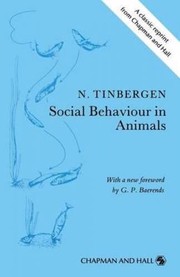Check nearby libraries
Buy this book

THIS book is a revised and translated version of a Dutch text which originally appeared in 1946. Tinbergen had written it during the war, much of it when he was imprisoned in a German hostage camp. He based it largely on his own observations and research which he had carried out in the late 1920s and the 1930s, a time that included the seven years in which he introduced the newly developing discipline of ethology into the biological curriculum of the University of Leiden. [...]
The original Dutch title can be translated as 'Animal Sociology'. The book was conceived at a time when in botany plant sociology had become very popular. This made ecologically oriented zoologists keen to develop a zoological counterpart. Tinbergen, however, pointed out that whereas plant sociology was mainly concerned with types of vegetation and the relationships between different species of plants, animal sociology should primarily focus upon the interrelationships between individuals of the same species, and should thus be seen as more closely allied to human sociology.
The book has become a classic. [...]
Before he died in December 1988, Tinbergen felt somewhat ambivalent about the appearance of a facsimile edition of his book. On the one hand he liked the idea because he believed its educational value had not diminished. On the other hand, he was aware that the book contained certain interpretations of behaviour which no longer hold today and which he himself had abandoned or revised. This, however, only demonstrates how productive Tinbergen's approach has been; it has contributed to the spectacular development of the discipline of behavioural ecology in the last three decades. At the request of the publisher I have in the following tried to point out, for newcomers in this field in particular, where views have changed importantly, combining this with a rough sketch of the trends taken in behavioural ecology. [From the foreword by G. P. Baerends]
Check nearby libraries
Buy this book

Previews available in: English
| Edition | Availability |
|---|---|
|
1
Social behaviour in animals: With Special Reference to Vertebrates
1990, Chapman & Hall
paperback
in English
0412369206 9780412369209
|
aaaa
Libraries near you:
WorldCat
|
|
2
Social behaviour in animals: with special reference to vertebrates
1972, Chapman and Hall
in English
|
zzzz
Libraries near you:
WorldCat
|
|
3
Social behaviour in animals: with special reference to vertebrates
1965, Chapman and Hall, distributed in the U.S.A. by Halsted Press
in English
0412200007 9780412200007
|
zzzz
Libraries near you:
WorldCat
|
| 4 |
zzzz
|
| 5 |
eeee
Libraries near you:
WorldCat
|
| 6 |
zzzz
|
Book Details
Table of Contents
Edition Notes
Facsimile reprint of 1st English edition 1953
Classifications
Contributors
The Physical Object
ID Numbers
Work Description
This is the revised translation of the Dutch original Inleiding tot de diersociologie [Introduction to Animal Sociology] published in 1946. The 1st English edition was published in 1953, and went through several reprints: remarkable among them being the 1990 facsimile reprint, with a new foreword by G. P. Baerends. The Foreword details Tinbergen's views about the reissue of the book, prior to his death in 1988.
From the author's Preface:
THIS book is not intended as an exhaustive review of facts. Its aim is rather the presentation of a biological approach to the phenomena of social behaviour. This type of approach was revived by Lorenz's pioneer studies. It is characterized by emphasis on the need for renewed and careful observation of the huge variety of social phenomena occurring in nature; by emphasis on a balanced study of the three main biological problems - function, causation, evolution; by emphasis on an appropriate sequence of description, qualitative analysis, quantitative analysis; and finally by emphasis on the need for continuous re-synthesis. [...]
The nature of the approach makes this book essentially different from other books on social behaviour. [...] I considered it of great importance to work out the formulation of the main problems, of their relation to each other and to more special, subordinated problems. This task, together with the necessary descriptions of many new facts found through 'naturalistic' study, and with the first qualitative steps of analysis, required much space. In addition, I wanted to formulate and emphasize some new theories which I consider important because of their great heuristic value. Thus the significance of intraspecific fighting, the causation of threat and courtship behaviour, the functions of releasers, and other problems to which the new approach has made distinct contribution~, have been presented in some detail, and an attempt has been made to give them their proper place in the complex system of problems.
Community Reviews (0)
Feedback?| December 12, 2023 | Edited by MARC Bot | import existing book |
| November 28, 2023 | Edited by MARC Bot | import existing book |
| September 25, 2014 | Edited by contulmmiv | Added new cover |
| September 25, 2014 | Edited by contulmmiv | Added description |
| December 9, 2009 | Created by WorkBot | add works page |












